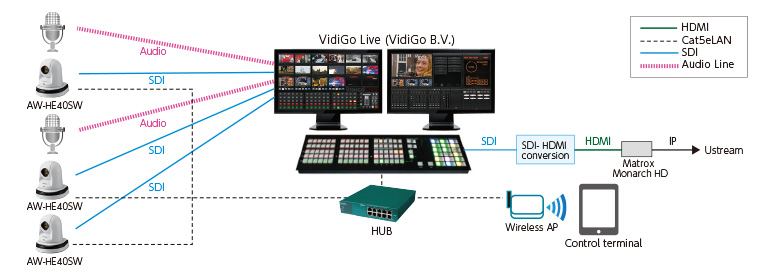Case Studies: RKK Kumamoto Broadcasting Co., Ltd. (Japan)
Ustream video streaming system in collaboration
with VidiGo Live
Clear video and versatile direction in Ustream video streaming as well as labor savings in operations

VidiGo Live (left) and AW-HE40SW* (right)
Boasting a broadcasting history of more than 60 years, RKK Kumamoto Broadcasting Co., Ltd. was founded as a radio station in 1953 and began television broadcasting six years later. The radio station has been taking Internet-based initiatives one after another, including iTunes Store podcast distribution and the station's first Ustream video streaming in 2010 and the subsequent start of "RADIPARA" Internet radio. With this multifaceted approach to providing programs, the station has worked against the downward trend in radio broadcast listener numbers in Japan. At the same time, however, it needs to minimize non-broadcast costs and labor so it is searching for ways to both add listeners and cut costs. With these circumstances in mind, Kei Okuda (star of the station's "Kei Okuda Sansan Radio" morning radio program) became interested in VidiGo B.V.s' "VidiGo Live" Ustream video streaming system, which was exhibited at the 2014 Qshu Broadcasting Equipment Exhibition. Okuda later did a trial broadcast studio installation of that system along with three AW-HE40SW HD integrated cameras (introduced in February 2015). This was the first attempt to operate the new AW-HE40SW together with VidiGo Live in Japan. The AW-HE40SW does not just enable clear video and versatile direction in Ustream video streaming, it also provides labor savings in operations by automating certain functions.
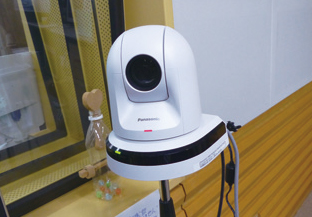
Main camera capturing main radio personality Kei Okuda
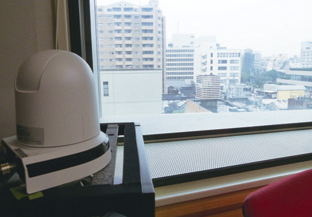
Shooting the cityscape in the center of Kumamoto
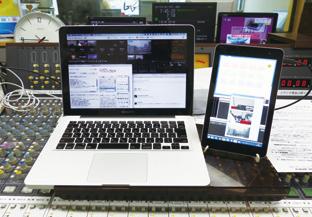
Ustream control terminal placed on mixer table. The tablet is used for camera control.
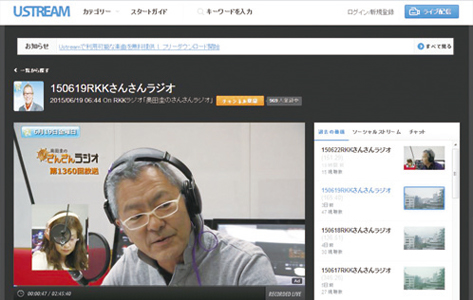
Video streamed with Ustream
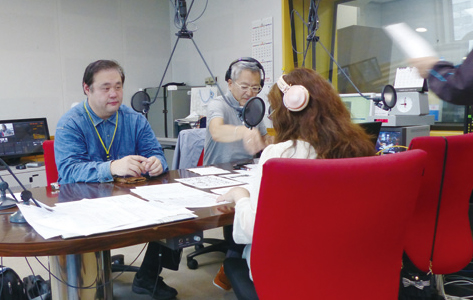
Studio scene during a live broadcast (facing the camera are main radio personality Kei Okuda at right and the guest at left; the assistant is in the foreground
Equipment Installed
Ustream is a strong tool for making people aware of radio as a “new media.”
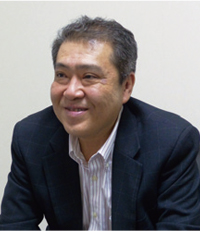
Akihiko Tajima,
Department Manager
RKK Kumamoto Broadcasting Co., Ltd.
Media Production Bureau, Radio
Production Department
Unfortunately, today's young people are listening to radio less and less. We are actively trying new things because we want to increase opportunities for them to come in contact with radio. This particularly applies to Ustream as we see it as a strong tool for making people aware of radio as a "new media" because of its ability to deliver radio using video. We were already actively working to make use of the Internet to supplement our main broadcasts by utilizing our own streaming system to stream "RADIPARA" and by moving quickly to utilize Ustream. The main broadcast itself is, naturally, the most important thing so there is a need for us to not expend too much effort on other work. For example, if we spend excessive energy on Ustream camera blocking and switching, we could end up neglecting the main broadcast, which would be a case of putting the cart before the horse.
Morning show radio personality Kei Okuda discovered and brought to our attention the existence of the VidiGo Live Ustream video streaming system,for which Japan Material Co., Ltd. serves as agent in Japan. We were working to expand listener reach, but I was facing the dilemma of also wanting to reduce the impact such operations have on our main broadcast. So we had the system brought into our studio for a trial. For the photography, we utilized Panasonic commercial-use cameras in a three-camera configuration with one shooting the cityscape outside, one shooting Okuda, and one shooting his assistant. The results produced by the system were revolutionary. It achieved what I wanted to a high degree, and it did it reliably and with little effort expended. At our company, we now have three radio studios doing live broadcasting, and I want to expand our use of the system to other studios and programs.
This system has possibilities. Perhaps it is not such a good idea for me to propose a return to "studying while listening to the radio," but I want to use the system to create a world in which radio is always close at hand.

Akihiko Tajima,
Department Manager
RKK Kumamoto Broadcasting Co., Ltd.
Media Production Bureau, Radio
Production Department
Unfortunately, today's young people are listening to radio less and less. We are actively trying new things because we want to increase opportunities for them to come in contact with radio. This particularly applies to Ustream as we see it as a strong tool for making people aware of radio as a "new media" because of its ability to deliver radio using video. We were already actively working to make use of the Internet to supplement our main broadcasts by utilizing our own streaming system to stream "RADIPARA" and by moving quickly to utilize Ustream. The main broadcast itself is, naturally, the most important thing so there is a need for us to not expend too much effort on other work. For example, if we spend excessive energy on Ustream camera blocking and switching, we could end up neglecting the main broadcast, which would be a case of putting the cart before the horse.
Morning show radio personality Kei Okuda discovered and brought to our attention the existence of the VidiGo Live Ustream video streaming system,for which Japan Material Co., Ltd. serves as agent in Japan. We were working to expand listener reach, but I was facing the dilemma of also wanting to reduce the impact such operations have on our main broadcast. So we had the system brought into our studio for a trial. For the photography, we utilized Panasonic commercial-use cameras in a three-camera configuration with one shooting the cityscape outside, one shooting Okuda, and one shooting his assistant. The results produced by the system were revolutionary. It achieved what I wanted to a high degree, and it did it reliably and with little effort expended. At our company, we now have three radio studios doing live broadcasting, and I want to expand our use of the system to other studios and programs.
This system has possibilities. Perhaps it is not such a good idea for me to propose a return to "studying while listening to the radio," but I want to use the system to create a world in which radio is always close at hand.
With a radio program as the base, it becomes possible to do information sharing with the information visible in real time.
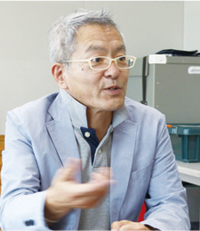
Kei Okuda,
Producer and Representative Director of Neverland LLC
(Radio personality on “Kei Okuda Sansan Radio”)
Radio Ustream video streaming started at RKK about five years ago, which was also about the time that my radio program began. Partly for that reason, on my program we introduced Ustream from the start. Initially the streaming was done with a simple system, but I came across our current system at the 2014 Qshu Broadcasting Equipment Exhibition. It was an intriguing system and my interest grew to the point where I discussed it with RKK, which decided to try actually using it.
The VidiGo staff watched my program over a long period so they made various useful proposals. For example, when an affiliated station' s broadcast is played during the program, we cannot stream it on Ustream due to rights considerations. So they wrote us a program to automatically switch to the camera showing the scene outside the studio at times when the Ustream audio is interrupted for three seconds. The director no longer has to take any action personally. The cameras we use are now AW-HE40SWs from Panasonic so the images are dramatically vivid and the conditions in the streets can be clearly seen, which has made our viewers very happy. The atmosphere in the studio is also clearly communicated during talk segments. Since the depth and nuances of the scene are communicated, it gives the feeling of being there in person, and we are able to incorporate comments from Ustream viewers during the live broadcast and fine tune program direction using those comments. Furthermore, it is not just image quality that has improved. Now we have many programs broadcast with a fixed-position camera, and from direction and other perspectives, it is a major factor to be able to easily carry out a variety of camerawork, such as zoom and pan/tilt operations, with the integrated pan/tilt camera. Today' s listeners have a sophisticated eye, and they get bored with a single shot that is fixed from start to finish.
In addition, VidiGo Live can easily put in wipes and subtitles. In situations such as a natural disaster, for example, we will be able to do real time presentation of listener-submitted photographs showing conditions in various areas so real time visual information sharing will be possible with a radio program as the base. In the carrying out of radio' s mission of the rapid communication of information, the addition of video makes it possible to communicate with listeners at a heightened level.
Finally, new ideas have arisen with respect to the aforementioned times when content cannot be streamed with Ustream. Now we just show the cityscape outside the window, but in the future we could show Kumamoto tourist information to our "listeners" in other prefectures and abroad. In other words, those times could serve as advertising slots. There are still more interesting possibilities that remain to be discovered. Dreams have a way of growing, don't they ?
The AW-HE40 Series contains cameras that are very easy to integrate into the system.
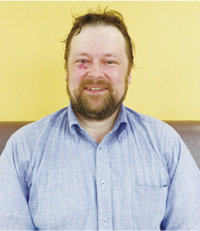
Andrew Hoddinott,
Engineer
Japan Material Co., Ltd.
My company serves as the agent in Japan for VidiGo B.V. of the Netherlands. For several years now we have been using Panasonic's HD integrated cameras almost exclusively, and there are good reasons for that. For instance, those cameras enable us to flexibly build systems tailored to their intended use. A specific example of how is the public availability of the API. There are many cameras for which companies will disclose the API if asked, but having the API available from the beginning helps the development to proceed very smoothly from a programming perspective. The end result is that we become able to quickly provide the customer with a proposal with sound content. One more characteristic that makes the system easy to develop is that TCI/IP is not optional. When an application is created, the camera itself has a function able to access a browser so no stress is placed on the development. Today, it is a given that the video should be good. We are a system integrator that builds new systems and creates value by combining devices with open API, and I think that for a company like us, ease of development is an important factor. This time we were able to provide a system for use by Mr. Okuda, who had been interested in our system for some time. I think that at present it is a system that is still evolving. Mr. Okuda's program is the one that is closest in format to overseas visual radio programs where on-screen titles change for each program time segment and the direction utilizes varied camerawork, and there more proposals I would like to make, such as direction using wide shots of all three people when three people are talking. Such proposals are only possible because the flexible cameras of Panasonic are being used. We have high expectations for those cameras.
[For inquiries concerning VidiGo Live]
Japan Material Co., Ltd. http://www.jmgs.jp/
System configuration
